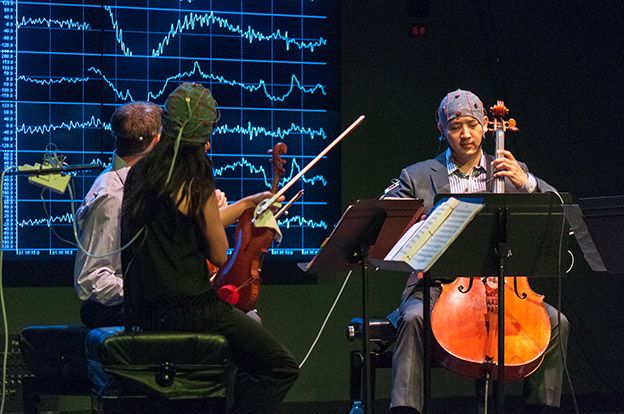Studying the sounds of science

Performers play in McMaster's new LIVELab facility. The interactive lab will allow researchers to study a nearly limitless set of applications related to music, rhythm and hearing.
A new one-of-a-kind virtual acoustics lab and theatre, wired to mimic nearly any conceivable environment, is set to open at McMaster University.
The $8-million facility—nearly a decade in the planning and construction—allows researchers to explore how musicians perform together, how rhythm might help an autistic child or Parkinson’s patient, and how hearing aids might work better in noisy settings, among other endeavors.
“The research applications are almost limitless,” explains Laurel Trainor, director of the McMaster Institute for Music & the Mind and professor in the department of Psychology, Neuroscience and Behaviour.
The lab’s sophisticated technology includes dozens of microphones and speakers in its specially-constructed walls and ceiling that can change the acoustics in an instant, turning the theatre into a virtual subway platform, noisy restaurant or world class concert hall.

“We’ve gone to great lengths to make the facility extremely quiet, isolated from the outside and low in reverberation. Then, we can artificially add in whatever echoes and reverberation we want, to make it sound like any space we want,” says technical director Dan Bosnyak.
The facility, known as the LIVELab, or Large Interactive Virtual Environment, is also equipped with dense-array EEG technology to measure brain activity in musicians as they perform.
Seats within the concert hall are designed so audience members can be wired to monitor their brain activity, heart rate, and breathing rate as they listen to live performances or watch images played on a large video wall. Motion capture technology can be used to analyze how musicians and dancers, and even audience members, coordinate their movements.
“We can start to ask big research questions like: How do musicians interact with each other? How do they coordinate to play together and how do their brains accomplish that? How do audiences react? And how does the energy from audiences affect performers? Now we can really start to understand how these complex dynamics take place,” says Trainor.
Neuroscientists and academics from all Faculties will conduct research on a wide range of subjects, including hearing impairment and tinnitus, diagnosing and treating cognitive impairment and decline, how best to teach students, how specific populations—including those with mild cognitive impairments and developmental coordination disorders—benefit from movement and music, and how best to use music therapies to treat depression and other disorders.
An open house and live performance demonstration will take place:
Saturday, September 27th
12 p.m. to 3 p.m.
Psychology Building, 2nd Floor
McMaster University
What people are saying about McMaster’s new LIVELab:
“As the first of its kind in the world, the opportunities presented by this exceptional facility are enormous. Music is such a fundamental part of our lives and researchers from across the university—and beyond—will collaborate in a unique environment where they will gain a deeper understanding of its importance to individuals and to society at large.”
-Patrick Deane, President, McMaster University
“Our government has made record commitments to science, technology and innovation to create jobs, increase economic prosperity and improve the quality of life of Canadians. Our investment in McMaster’s state-of-the-art LIVElab will improve the health and well-being of Canadians by conducting important research into areas such as hearing and mild cognitive impairments, autism and depression.”
– Honourable Ed Holder, Minister of State (Science and Technology)
“This state-of-the-art facility will enable researchers from vastly different disciplines — from music to neuroscience — to come together to study the relationship between sound and human behaviour. The breakthroughs produced at the LIVELab will be of critical importance to Hamilton’s growing community of performers and entrepreneurs, who will be able to harness the science of sound to amplify the impact of their music and technologies.”
-Gilles Patry, President and CEO, Canada Foundation for Innovation
“LIVELab’s impressive multidisciplinary approach aligns with Ontario’s goal of fostering a collaborative research ecosystem. Innovative projects like LIVELab will no doubt lead to partnerships that will deliver cutting edge human health and wellness solutions for people in Ontario and around the world.”
– Reza Moridi, Ontario’s Minister of Research and Innovation
